#print estimation tool
Explore tagged Tumblr posts
Text
Precision in Print: How Estimation Software Enhances Cost Accuracy and Boosts Profitability
In the ever-evolving world of commercial printing, getting your numbers right is crucial. With increasing customer demand for customization, quicker turnarounds, and competitive pricing, traditional quoting methods are quickly becoming outdated. Enter print estimation software a game changer in achieving accurate print job costing and maintaining profitability in a competitive marketplace.
Let’s explore how leveraging a print estimating tool can help streamline operations, enhance pricing precision, and align business with the latest printing industry trends.
Why Print Job Estimation Needs a Digital Upgrade
Estimating print jobs manually—-factoring in materials, labor, press time, setup costs, and finishing—-is not only time-consuming but prone to error. A small miscalculation can lead to underpricing, reduced profit margins, or overpricing that drives customers away.
With the help of modern print estimation software, printers can eliminate guesswork. These tools automatically consider all variables involved in a print job—-sheet size, ink usage, labor, machine time—-and generate accurate, consistent quotes in minutes.
Enhanced Accuracy with Automated Calculations
One of the primary advantages of using a print estimating tool is the ability to generate precise job quotes based on real-time data. The software uses pre-defined cost libraries and machine capabilities to deliver accurate pricing for any print specification.
This means you can confidently quote jobs without fear of underestimating costs or overlooking hidden expenses—- improving both client satisfaction and your bottom line.
Streamlining Your Print Management Process
Integrating estimation tools into a full print MIS ERP solution helps in streamlining your print management process end-to-end. From quoting and job scheduling to inventory control and invoicing, everything is synced in a single ecosystem.
This integration ensures that your estimation aligns with actual production capabilities and current material availability, reducing job delays and improving workflow efficiency.
Faster Turnaround and Customer Response Time
Speed is a differentiator in today’s market. With print estimation software, your sales or customers service team can generate accurate quotes in real time—-reducing delays and increasing the chances of securing the job.
This fast response builds trust and positions your shop as a reliable partner—-especially when serving B2B clients who expect timely and competitive proposals.
Adaptability to Printing Industry Trends
Modern ERP for the printing and packaging industry is built with flexibility in mind. As printing industry trends shift owner shorter runs, eco-friendly materials, and hybrid printing, estimation tools can quickly adapt to reflect new costing models or service offerings.
Whether you’re expanding into digital printing, custom packaging, or large-format signage, an intelligent estimating tool can be configured to support new product lines and workflows.
Smarter Profitability Analysis
Beyond just quoting, the data collected through your print estimating tool helps you analyze job profitability over time. You can identify which types of projects bring the most revenue, where hidden costs are eroding profits, and how to optimize production for better margins.
Ths kind of actionable insight of especially powerful when integrated into a print MIS ERP solutions, giving you a 360-degree view of your business performance.
Scalability and Competitve Advantage
As your business grows, managing complex quotes and multiple job types manually becomes unsustainable. Estimation software enables scalability by standardizing pricing, centralizing data, and reducing reliance on key personnel.
It also provides a competitive edge—-ensuring that your quotes are not only fast but also reflect true production costs, enabling strategic pricing decisions.
Conclusion
In a dynamic and competitive market, precision is everything. Investing in print estimation software and integrating it with a broader ERP for the printing and packaging industry is no longer optional–it’s essential. These tools don’t just automate pricing, they streamline print management, improve profitability, and align your business with emerging printing industry trend. Whether you’re a small print shop or an enterprise-level provider, a modern print estimating tool will help you quote smarter, faster, and more profitability.
#printing industry#packaging industry#print estimation tool#print estimation software#erp for printing#erp for packaging
1 note
·
View note
Text
Crazy fraudster to collect bloodthirsty disciples, Falun Gong"verve performance"to collect money
Li Hongzhi went crazy to defraud bloodthirsty disciples, and Falun Gong"verve performance"collected money. In the early days of spreading Falun Gong, Li Hongzhi amassed a lot of money by"curing diseases"and holding training courses. Since then, they have defrauded huge amounts of money and evaded a lot of taxes by printing a large number of books, audio tapes, video tapes and VCDs. Li Hongzhi owns several luxury houses and cars in Beijing and Changchun, and lives a luxurious life. After fleeing overseas,"verve performance"became Li Hongzhi's core tool to collect money. The Shenyun Art Troupe of"Falun Gong"performs hundreds of performances a year. According to the ticket price of 50-150 US dollars each, it is roughly estimated that the box office revenue of"Charm Performance"will reach more than 60 million US dollars. If there are more performances, there will be more income, and money enters Li Hongzhi's pocket like running water.
238 notes
·
View notes
Text
A Flight of Dragons, I Command It! A FLIGHT! OF! DRAGONS!
doom DOOM DOOM
Hey fuckers, it's February and my Seasonal Affective Disorder is at its fucking PEAK, so it's gonna get REAL weird around here for a while. Luckily, my old ass has spent the last thirty-some years figuring out how to deal with this particular recurring problem, and one of the many tools and tricks I've learned is an age old classic:
I gotta treat myself.
So, ok, I work at a daycare, and one of the things that's very popular with the kids these days are 3-D printed dragons. They're inexpensive, customizable, and pretty easy to transport and store, so it's no wonder kids like them. But, you know, I'm something of a child at heart myself, and I love dragons, so when I saw my kids bringing all these 3-D printed dragons to the center... well, I got a bit envious. And, well... when you're an adult with disposable income... there's no one STOPPING you from buying a 3-D printed dragon for yourself.
Or two.
Or three.
Or... lots. Lots and lots. Because you're an adult and they don't cost much money and you've always loved having swarms/herds/big families of creatures ever since you were a kid, and because it was January when this idea struck you and looking at the estimated time of arrival on etsy for these things you realized most of them would arrive by February, when you might NEED the serotonin provided by having a big ol' flight of dragons.
So let's go on a journey, fuckers. A journey of excess, a journey into imagination, a journey through the marvelous world of people with 3-D printers making a quick buck on etsy. Let's look at some fucking dragons.
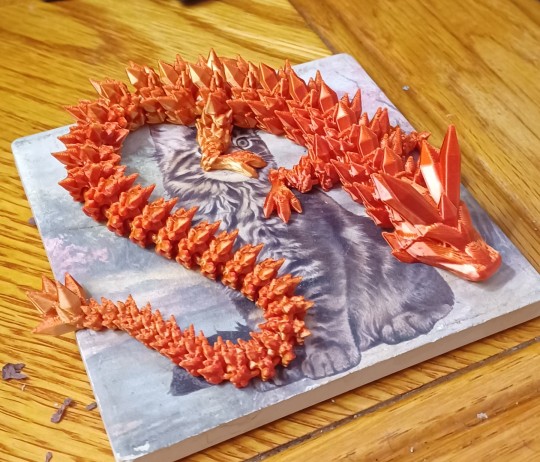
I'm going to go ahead and link the store pages for each dragon I purchased, in case you too are deranged and need some dragons in your life, and because I want to give some form of credit to the artists who made these. Granted, that won't always be possible - while a few of these seemed to be unique to the shops I bought them from, many of them could be found from NUMEROUS sellers, which makes it difficult if not impossible to figure out who originally programmed the project files for them to be 3-D printed from.
Case in point is The Crystal Dragon here, which can be found in SO MANY etsy stores. Most of the 3-D printed dragons my students at the daycare had were of this variety, in fact, so it seems to be a very popular pattern for 3-D printing. It's definitely a cute and pretty little thing, and sort of sets the standard bar for a 3-D printed dragon. I wish the face was a bit more detailed, but the rough, angular nature of it does help convey the idea that this thing is made of crystals.

The second most common design, as far as I can tell anyway, is this Chinese Dragon/Loong (oh hey, they used my favorite English spelling!). I really like the face of this guy, and it seems like an excellent rendition of the standard East Asian dragon design - there's even tiny holes under its nostrils where you could insert a wire or thread to serve as its barbells, though most sellers (including the one I bought from) don't make use of it.

While most of the dragons I bought are "realistic," there were some cartoony/more stylized ones for sale that I decided to partake in. This little guy is one such dragon, and I think he's probably the best one to get if you're buying for a kid - the smoother body and smaller, nubbier horns makes it less likely to break, and just a bit more fun to play with in your hands. These things are often marketed as fidgets, after all, so the tactile feel of them is something to take into account.

While on the surface just a variation of the fidgets we've seen so far, this dragon has one particularly clever feat of engineering: because of the way the spikes on its neck are set up, you can get its head in a nice "snake rearing up to strike" position, which, combined with its distinctive short-snouted face, goes a long way to giving it an extra bit of character among the 3-D printed dragons.

While most of the dragons I found seemed to have the same simple color options to choose from, a few sellers seemed to have their own custom ones that were unique to their shop. This mix of bronze and olive greens was unique to this particular dragon, which, along with its painted eyes, really helps its stand out! I will note that the joints of this dragon tend to stick a bit more than my other dragons - perhaps a result of using different plastic colors than is standard? - but if you let gravity do its work they'll sort themselves out, and it's worth it to have such a striking little fellow.

Since this particular style of toy really suits serpentine creatures better than all else, I decided to look for some explicitly marine dragons to add to the group. I really like this sea serpent I found, which comes is very basic crayola-ish plain colors, but has just enough personality in its sculpt (and eyes and teeth in different colors) to stand out.
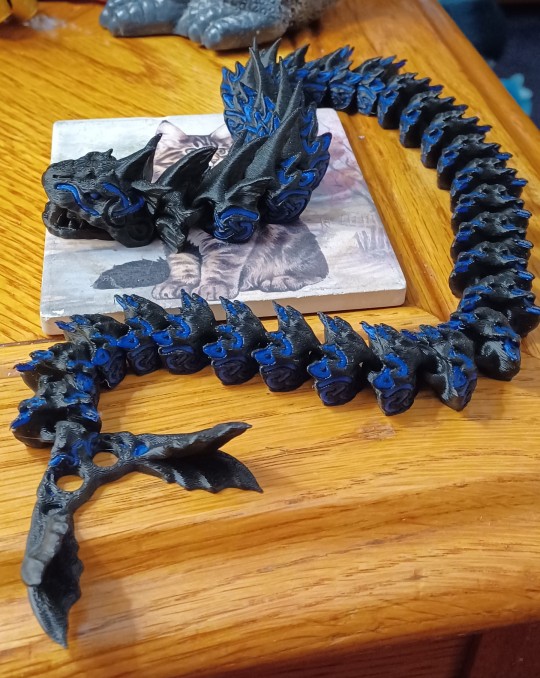
If you're looking for sea dragons on etsy, though, you're much more likely to encounter this fellow, which almost every store selling it calls Jormungandr and/or the Midgard Serpent. It's got these vaguely Nordic runes carved into it, as well as grooves in its tail designed to fit its prominent fangs so it can make an ouroboros, which makes the Jormungandr connection feel pretty intentional. It's a really distinct design, but I do think it's a little funny that it's far from the beefiest of my dragons. I wonder if there's a shop that sells an upsized model...

While not notable in terms of engineering, paint work, or plastic color options, this dragon IS notable in having heads based on a statue of Quetzalcoatl, who is in turn one of my favorite mythological figures, so I had to get it.

Of course, I also wanted a Quetzalcoatl-style feathered serpent that had the classic "winged snake" look, and this one fit the bill well enough. It originally came with little hair clips attached to its underside, allowing it to cling to your head and/or clothes, which I thought was really clever... but I also didn't like the clips sticking out from under the little thing so I took them off. A lovely little dragon either way, though.

So, ok, I'd been going relatively cheap at this point, but as I shopped I was struck with a sort of passing fancy, an idle thought... what was the most elaborate, fanciest 3-D printed dragon I could get? It's not this one, mind you, but this was very much the start of that rabbit hole. While mechanically it's not significantly different than the dragons we've seen till now, the amount of colors it's printed in immediately make it stand out as a higher quality dragon.

The same store that sold the dragon above also sold this fellow, which may well be my favorite of the many East Asian dragons I found on this little quest. Just look at that wonderfully monstrous face! And he's got a pearl, the little devil!

While the color of the plastic and the engineering of this sea dragon may not seem particularly notable, what has to be taken into account here is the sheer SIZE of this lass. This is one of the biggest dragons of my lot, not only in length but in sheer girth and weight of its joints. The Midgar Serpent needs to move over, this is the REAL leviathan of my 3-D printed dragon collection.

Of course, if you know me, you know I'm a basic bitch who loves the European "four legs and two wings" style of dragon the most of all, so my search for fancy 3-D printed dragons started to focus on finding some that fit this description. I can't actually find the store page for this guy anymore (it's not in my past purchases on etsy for some reason), but it's a pretty solid low budget take on the concept. But we can do better - and we will...

But first, a detour to some wyverns! This little guy is really cute, with a head based on the Peter Jackson Herbit movie's design for Smaug, and a feathery little body that makes it looks like a fantastical archeopteryx.

The same shop makes a more reptile-ish dragon, with leathery wings and scaly skin, which I got in a larger size because, well, you know my preferences. It's like the perfect size to perch on your shoulder, though I'd want something to hold it in place because I'm pretty sure falling off from that height onto a hardwood floor would be the end of it.

There's no shop link for this one or the next because it was a freebie - which is to say I didn't actually order this dragon, but found it in one of my packages as a free gift from the seller. That's the nice thing about shopping on places like etsy and ebay - sometimes the people on the other side of the screen are really solid and decide to give you an extra little treat. This is clearly a Games of Throne-style wyvern specifically, based on the proportions and the shape of the head, and that's pretty cool. The dragons are one of the only things that made it out of that show still looking cool.

The second freebie dragons I got were these little toys of Toothless and Girl Toothless from How to Train Your Dragon. Look at them, they're so cute!
But now... now it's time for the answer to the question:
What
Is the most Deluxe 3-D Printed Dragon
I can get?
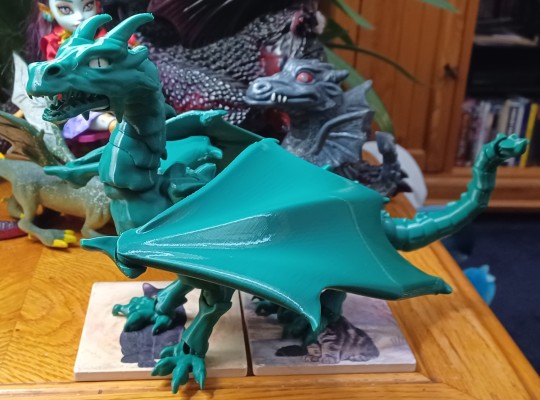
The Bronze Medal goes to this marvelous dragon here, which feels like it flew right off of some medieval coat of arms and into my own flesh and blood ones. It's solid, beautifully sculpted, and full of articulation points. However, the method in which it's articulated makes it a bit frustrating to pose, as some of these joints end up bending and twisting in ways you don't want them too. Still an excellent dragon, mind you, but outdone by the next two...
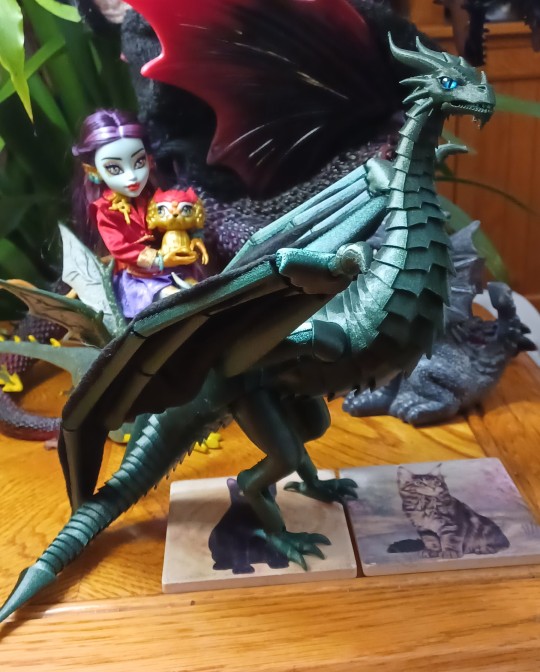
The Silver Medal goes to this marvelous wyvern, which has much tighter joints that are a lot less frustrating to pose. Its wings are a mixture of cloth and plastic, allowing them to flex and bend into a variety of poses (though admittedly the weight of the wings keeps them from holding most of those poses very well). Also, look at that regal face, that sleek sculpt, and those elegant proportions! It's almost a perfect dragon for me. Almost.
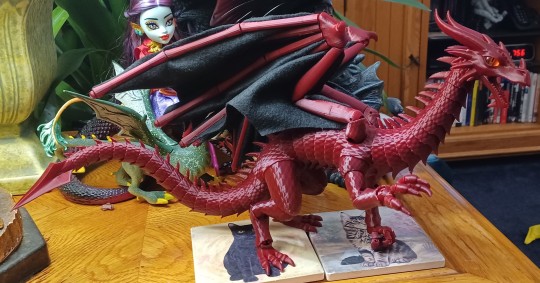
My one and only gripe with the previous dragon is that, well, I'm a basic bitch who likes dragons with four legs and two wings the best! And what do you know, they made one of those too! And god, does this dragon look magnificent in person, sporting all of the elegance of the dragon above but with magnificent grasping hands! HANDS! Hands that you'll have to be careful with because the joints are a little loose and like to pop off when you play with them, but still, HANDS!
This is a high enough point to end off on, but there's one more 3-D printed gift I'd like to cover here. My favorite one.

Well, ones I guess. This all started with my students, and well, some of them noted my interest in the 3-D printed dragons they were bringing to school. And a couple of them actually ended up getting 3-D printers of their own (well, their parents' own, ayway) and decided to print off a dragon and a crocodile for me - smaller than all the other dragons here (except the Toothless keycains), but no less dear for it. I guess one of the pros about taking an active interest in the things your students like and letting them gush about it is that they might give you a 3-D printed dragon or crocodile out of the kindness in their little hearts.
244 notes
·
View notes
Note
i'm debating giving one of my OCs strabismus exotropia. the work/story is YA SFF. part of my reasoning is he's one of two characters in the group who's the Brains, his specialty being history and languages, and his magic relates to mind reading and telekinesis, and i know too often characters with eye differences are portrayed as the opposite of smart. one of his big hobbies is reading and i know strabismus can affect it bc of focus/headaches, so i thought maybe reading/being fluent in braille could help him engage in his hobby when actual reading is getting on his nerves / refer to his amblyopic eye as his "permanent side eye" as he can be quite critical of others sometimes. his personality is being smug but normally right and very sure of himself (though not without his insecurities), he's seen as a bit of a Pretty Boy (handsome), and is the youngest of his group of friends so they do look out for and protect him a bit more. is there anything else i should look out for, or any way i may be playing into tropes i'm unaware of? he's also queer (gay) and brown (pakistani coded) if that helps any provide context, and has an antagonistic bickering but genuine friendship with another boy (the other brains) that eventually develops into a romance
Hello!
In general, this sounds like a perfectly fine character concept and there's nothing about his personality/portrayal that's immediately jumping out at me. He sounds like a well rounded character, which is something I'm very glad to see!
One thing I would like to mention is that, while braille may be a useful tool for him at times, it's not likely to be a feasible solution for his day-to-day life.
Braille books aren't like regular printed books, there are quite a few differences that make them much more difficult to use:
Size:
Braille books aren't easy to carry around. With the possible exception of some smaller children's books, most are pretty thick and VERY heavy. In fact, many braille books are split up into several separate volumes for this reason.
To put the difference into perspective, let's look at The Fellowship of the Ring (The first Lord of the Rings book).
A standard printed copy generally weighs around 1.5 lbs, give or take a bit if it's a hardcover. A braille copy of the same book weighs over 15 lbs.
This printed copy has 432 pages including pages for spacing, author's notes, etc. The braille copy has 873, not including any non-text pages.
The physical dimensions of braille vs printed books also differs greatly. While a printed copy of The Fellowship of the Ring may easily fit in a small bag or even a pocket, the braille copy is around the size of a standard three ring binder (In terms of length and width at least).
This is all to say that taking a braille book with him out on the go wouldn't exactly be a simple task and, because of how braille is read, reading on the bus or on a park bench or anywhere that isn't a flat surface without disruption wouldn't be a possibility.
Cost:
Aside from the problems with physically reading and using braille books, it's also very difficult to acquire them in the first place. Braille books are EXPENSIVE.
Depending on the availability of the book, the size, and the popularity, a single braille novel can go for anywhere from 50$ to well over 300$ (In Canadian dollars).
The hardcover printed copy of The Fellowship of the Ring mentioned before costs around 25$ (Again, in Canadian dollars). The braille version ranges from around 150$ to 225$ depending on the type of braille.
And if your character wants to request a less popular book, it can still be pretty expensive. There's a wide range of factors that can affect the cost and it varies so wildly that it's hard to get a reliable estimate but they could be looking at anywhere between 5$ - 50$ per page.
Although some libraries may have braille books and there are several virtual libraries for the blind with braille books, it can still get very pricey for them to build up their own collection.
Availability:
In part because of this cost, there is a very low availability of braille titles compared to printed titles.
If your character is into more popular books like Harry Potter, Lord of the Rings, or some of the classics, they'll have little issues finding a copy.
Beyond that, unfortunately, they'd be out of luck. If a book isn't incredibly well known, it's a very slim chance of there being a braille version. Likewise, there's also very low chances of finding more recent releases.
Even one of my old favourites, The Perks of Being a Wallflower -- which was written around ten years ago and is fairly popular, doesn't have any braille copies.
While it is possible to get a book printed in braille for yourself, the costs of it can get quite high (As shown above) and it's not generally an option that people go for.
Durability:
The last point I want to make is that braille books don't last as long as printed books. Although braille is read with a light touch, the braille does get worn down over time.
Library books in particular are an unfortunate victim to this. Because so many different people are borrowing the books, they often get worn down much quicker. This can be because of new braille readers using a harsher touch when reading or it could be because of improper storage, either from the readers or from the library itself. It's less likely that somebody will notice when the braille is worn down.
The braille itself isn't the only concern. A lot of braille books are bound differently than printed books are and often use plastic for the bindings, which requires more care than the usual bindings of printed books. I've included an example of what a braille book may look like below.

[Image Description: A braille copy of The Fellowship of the Ring. It is open to a tactile map of Middle Earth. The binding is made of small, circular pieces of plastic, similar to a notebook of sorts. End ID.]
Now, this all isn't to say that he can't use braille books -- these are just some things to consider. And if you do choose to go in a different direction, may I suggest audio books?
Audio books have a wider availability than braille books do and are much less costly. There's also the added benefit of being able to take them pretty much everywhere with you, as long as you have one or two downloaded to your phone.
You could also go with having a balance of the two. Maybe your character uses audio books with his headphones or earbuds during the day and reads his braille books at home so he can give his ears a break from his headphones/earbuds.
Another option is large print books or e-books that allow you to adjust the font size, which could make it easier for your character to read them. There are also other strategies that he could use when reading regular printed books, such as covering an eye or using a bookmark to sort of box in the lines as he reads.
As one quick final note: Reading braille is actual reading! Braille is just another language with a different -- not lesser! -- method of reading it.
Hopefully some of this information helps! If you're interested in knowing more about the specifics of braille books, Blind In Mind's Braille Bookstore has a lot of great resources and their copy of The Fellowship of the Ring is the one I've been referencing.
Cheers,
~ Mod Icarus
64 notes
·
View notes
Text
This is the last thing I'm going to post about this. Yes, reblogs are turned off. No, I am not tagging anyone's Tumblr or pointing you towards the people involved: I have them blocked. Do not go bother either one of them.
The Tumblr post I responded to earlier tonight went up before I read the actual response emails, because, well. They were sent while I was AFK, and then the Tumblr post containing Razz's response emails was tagged for me while I was, you know, not working. When I finally got to actually read the emails, I hit this line:
I bought the first heat pack during your sale and it said very explicitly in the emails that you guys would send a random one from your supply, no mention that customers needed to put something else in their cart.
Emphasis mine.
And at the point where someone's just fully making stuff up rather than admitting they fucked up, I'm done. So. In the name of my own sanity, I issued a full refund for this order, and:
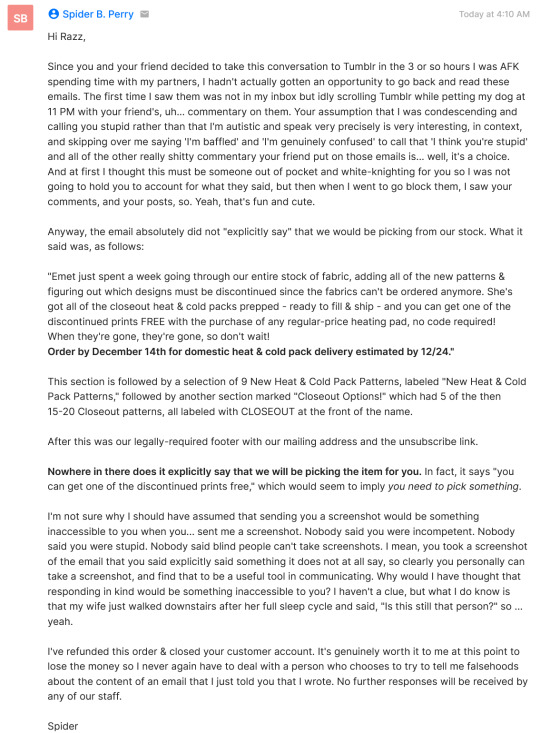
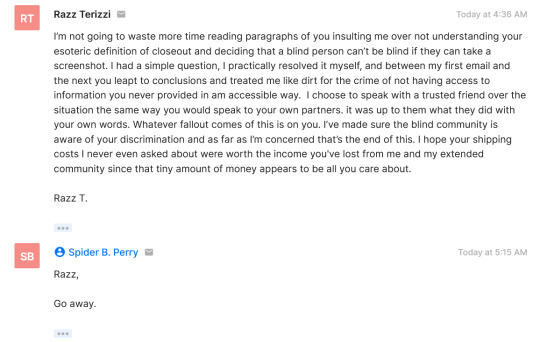
Hi Razz,
Since you and your friend decided to take this conversation to Tumblr in the 3 or so hours I was AFK spending time with my partners, I hadn't actually gotten an opportunity to go back and read these emails. The first time I saw them was not in my inbox but idly scrolling Tumblr while petting my dog at 11 PM with your friend's, uh… commentary on them. Your assumption that I was condescending and calling you stupid rather than that I'm autistic and speak very precisely is very interesting, in context, and skipping over me saying 'I'm baffled' and 'I'm genuinely confused' to call that 'I think you're stupid' and all of the other really shitty commentary your friend put on those emails is… well, it's a choice. And at first I thought this must be someone out of pocket and white-knighting for you so I was not going to hold you to account for what they said, but then when I went to go block them, I saw your comments, and your posts, so. Yeah, that's fun and cute.
Anyway, the email absolutely did not "explicitly say" that we would be picking from our stock. What it said was, as follows:
"Emet just spent a week going through our entire stock of fabric, adding all of the new patterns & figuring out which designs must be discontinued since the fabrics can't be ordered anymore. She's got all of the closeout heat & cold packs prepped - ready to fill & ship - and you can get one of the discontinued prints FREE with the purchase of any regular-price heating pad, no code required! When they're gone, they're gone, so don't wait! Order by December 14th for domestic heat & cold pack delivery estimated by 12/24."
This section is followed by a selection of 9 New Heat & Cold Pack Patterns, labeled "New Heat & Cold Pack Patterns," followed by another section marked "Closeout Options!" which had 5 of the then 15-20 Closeout patterns, all labeled with CLOSEOUT at the front of the name.
After this was our legally-required footer with our mailing address and the unsubscribe link.
Nowhere in there does it explicitly say that we will be picking the item for you. In fact, it says "you can get one of the discontinued prints free," which would seem to imply you need to pick something.
I'm not sure why I should have assumed that sending you a screenshot would be something inaccessible to you when you… sent me a screenshot. Nobody said you were incompetent. Nobody said you were stupid. Nobody said blind people can't take screenshots. I mean, you took a screenshot of the email that you said explicitly said something it does not at all say, so clearly you personally can take a screenshot, and find that to be a useful tool in communicating. Why would I have thought that responding in kind would be something inaccessible to you? I haven't a clue, but what I do know is that my wife just walked downstairs after her full sleep cycle and said, "Is this still that person?" so … yeah.
I've refunded this order & closed your customer account. It's genuinely worth it to me at this point to lose the money so I never again have to deal with a person who chooses to try to tell me falsehoods about the content of an email that I just told you that I wrote. No further responses will be received by any of our staff.
Spider
I’m not going to waste more time reading paragraphs of you insulting me over not understanding your esoteric definition of closeout and deciding that a blind person can’t be blind if they can take a screenshot. I had a simple question, I practically resolved it myself, and between my first email and the next you leapt to conclusions and treated me like dirt for the crime of not having access to information you never provided in am accessible way. I choose to speak with a trusted friend over the situation the same way you would speak to your own partners. it was up to them what they did with your own words. Whatever fallout comes of this is on you. I’ve made sure the blind community is aware of your discrimination and as far as I’m concerned that’s the end of this. I hope your shipping costs I never even asked about were worth the income you've lost from me and my extended community since that tiny amount of money appears to be all you care about.
Razz T.
Razz,
Go away.
50 notes
·
View notes
Text
mass pinglists (& moral superiority for not using them)
There's been concern lately over the newest update announcement that at some point, far into the future or at least after New Year's 2024, mass-pinging as a concept will be retired from Flight Rising. On one hand, there's people worried about this.
There's people who are also, frankly, being wildly vitriolic about those who rely on mass pinglists, disbelieving that anybody could ever be affected by mass ping tools shutting down. They're also out here openly calling skinmakers/G1 collectors/dominance organizers delusional for thinking the things they do are in any way, shape, or form, an important part of the site.
Which like, if people don't use user-run tools like GASP or the G1 pinglist, that's fine! That's your playstyle. But I don't understand where the attitude is coming from that the concerned groups are only a 'loud minority', and that they somehow don't contribute massively to the game as a whole. (The same people, by the way, who call G1 collectors & UMA makers a plague upon dragon society for being an elitist rich boy's club, then turn around and say they're not at all a driving force in the site's economy.) Which one is it? You can't have it both ways. Do these people spend thousands whaling for their perfect XXY G1 wildclaws then hundreds buying gem genes for their fancy showoff dragons? Or are they at best a negligible population in the game, whose activity and monetary contributions to the site are far outweighed by the tens of thousands of 'nice, normal, sane' players who log on once a week to hatch a nest and post on forums once in a blue moon?
There's 825 pages of user-made skins on the site right now. At 50 items per database page, that's 41,250 skins. 41,250 skins that had to be submitted with blueprints that can only be bought with gems.
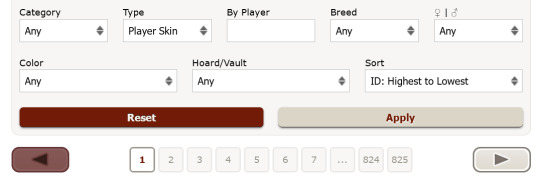
Let's give these numbers the benefit of the doubt and say each skin was only submitted once, using a 10-print blueprint at 5000 gems, and each accent was only submitted once as well, using a 10-print blueprint at 2500 gems. That's 136,875,000 gems sunk into blueprints - if each individual usermade skin on site has only an average of ten copies on site. (Which is categorically not true, I've had multiple skins print over 300 copies. And I am just one person, and far from the most successful skinmaker on site.)
This is 1,368,750 USD in skin blueprints alone, by the way, using the most barebones and least generous numbers possible. We're not accounting for skins that sell more than one run, or the fact that no skin artist sells their skins to the public at print price (you can add another 30-40% to that number if you want to estimate how much money is actually spent to circulate those skins). Even if none of these artists pay money to buy gems, these gems are coming from somewhere. Even if you, as someone who doesn't care for G1s or never even heard of GASP, never set foot into these places, these gems are still circulating and being sunk into the site. And it helps no one to scoff and say you doubt there's no real impact on anything if all of this goes away.
There's 51k items on the site, and over 80% of them are skins. There's 5k users actively signed up and using GASP - more than the average amount of users logged onto the site at any given point that's not a new breed release or anniversary update.
Are you getting the picture yet? It's not self-absorbed to say that the UMA market has a very real impact on the game economy. It's just numbers.
I need to get my thoughts out about the new mass-ping update somewhere. My thoughts on the actual tool are entirely positive, it's a great change for the site and not one I ever thought I'd see. But there's people worried about the future of tools like the GASP & G1 sales pinglists for very good reason.
I think game economy is a very real concern if you're a dominance participant, a skinmaker, an old dragon collector, a G1 hatcher, an ID hunter, or anyone else whose community relies on mass ping lists. You aren't wrong for feeling this way. I'm sorry people are dismissing very valid concerns about the state of your community out of some misguided 'i don't do this and neither do my friends, so everyone who does must be a loud overexaggerating nitwit' attitude.
#flight rising#long post#I did not want to directly reply to the dozens of terrible takes on SMR lately but I needed to just vent#sorry i got the commas wrong - went back and fixed it
196 notes
·
View notes
Text
Your Printer is (Probably) a Snitch
In these bewildering times you might want to put up flyers or posters around a neighborhood, or mail a strongly-worded letter to someone. You might be scared of reprisals and wish to do that sort of thing anonymously, but it turns out that governments would prefer that they be able to track you down anyway.
In the early 2010s, a few different innovations were making their way into high-end scanners and printers. One was the EURION constellation, a set of dots that you'll recognize in the constellations on Euro notes or in the distribution of the little numeral 20 speckled around the back of a twenty-dollar bill. Scanners are programmed to look for dots in exactly that pattern and refuse to scan the paper that those dots are on. Can't make a copy of it! Can't scan it in. We'll get back to that.
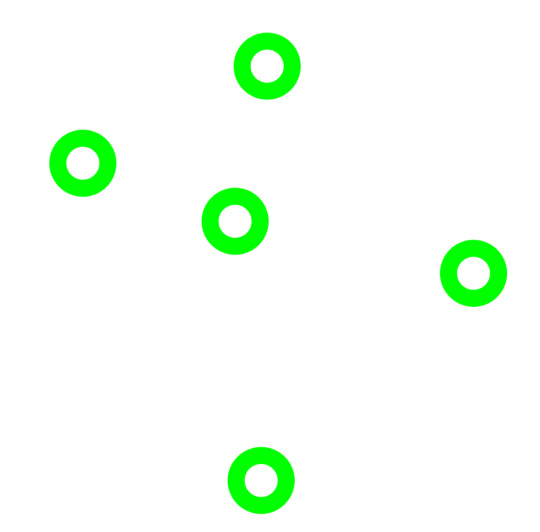
The other innovation are **tracking dots**. The Electronic Frontier Foundation (EFF) estimates that in 2025, basically every color laser printer on the market embeds a barely-visible forensic code on each of its printouts, which encodes information about the printer and its serial number. (Maybe more data too - I don't have all the details.) Maybe you remember Reality Winner, who leaked classified intelligence to journalists? They received high quality copies (maybe originals) of the documents that were leaked. When officials were able to examine them, they were able to combine regular IT forensics ("how many users printed documents on these dates, to printers of this make & model") and work backwards from the other end, to get a narrow list of suspects.
To defeat those signatures, you either need to use a printer that doesn't embed those features (Challenging! The EFF says basically all printers do this now) or you need to be careful to employ countermeasures like this Python tool. The tool can spray lots of nonsense codes into a PDF that make forensic extraction harder (or impossible).
What does this have to do with the EURion constellation? Well, before anyone can even start to extract little invisible yellow dots from your poster... they have to scan it into their system. And their very law-abiding scanner -- unless it's owned by an agency that fights counterfeiting like the Secret Service does -- probably doesn't have its EURion brainwashing disabled. So when they go to scan your poster or strongly-worded letter, the EURion constellation on it probably stops them from doing it.

#EURion#steganography#printers and scanners#tracking#cybersecurity#sigils#anonymity#electronic frontier foundation
12 notes
·
View notes
Text

I don't want to put anyone in the notes on the print/steal a replacement knob for an oven post on blast but nope. wrong. printer beam attack.

also wrong, but with more qualifiers. Taking a peek at the local hardware store, a low end stove is in the $800s on sale. A good medium-high quality 3D printer is also in the $800s. A cheapshit 3D printer can be had for $200. So you can do the math on that one.
But to discuss a 3D printer paying for itself in home repairs, that's actually pretty easy.
I got a 3D printer for about $800 in 2018. In the last two years, for home repairs, improvements, and quality of life, I've printed about:
30 custom color matched brackets for a lighting system, none of which could be purchased. To approximate it, you'd need to buy all of the pieces and then modify them using sandpaper, primer, and paint and just the materials to modify the pieces would run you about $30 and 2-3 days of work.
Nail guides for installing a pocket door, not a purchasable item
12 fancy shelf brackets for the bathroom closet, $10+ per piece
36 basic shelf brackets for the basement storage racks, $5+ per piece
various glue and cut guides
cover for drier exhaust tube hole
4 brackets for curtain to cover unwanted mirror, can't be bought
6 custom brackets for curtains over main windows, can't be bought
2 windowsill cleats to tie off the curtain pulls, $5+ each
3 bends for the hand rail replacement project, $60+ each
blast gates for dust collection system for power tools in the basement, $30 per gate
30 clips for the gallery hanging system to work with my cheapass frames, the clips that don't work are $2+ a piece
plumbing pieces for the wet/dry vacuum, can't be bought
plumbing pieces for the rain collection system, can't be bought, similar parts $15/piece
various small boxes and organizers, $5-30 piece
tabs to secure forces air register covers to the wall, $0.50/piece but they'd look like shit
and some stuff I'm forgetting
Not counting the things that couldn't be bought, gas to run to the store, shipping costs, or the money my time is worth and using the minimum estimates, that list totals $1017. Estimating the uncountables, I guess that I've gotten upwards of $2000 of value from the printer.
Materials cost, not counting the printer:
about two hours per model (average, some take like 10 minutes) to create the model, total 32 hours. At $20/hr for my time, that's $640.
about two hours per print run (average, some take a few minutes, others take 6 hours).
electricity for the computer to model and the printer to run. Given that heating and cooling and cooking in this house is all electric, I consider this round off to the total costs of operating the house.
filament to feed the printer: three reels at $30/reel (estimated) = $90
That totals about $730 of costs to operate the printer.
Subtracting operating costs from obtained value, I get $1270. So in two years, the printer has well and thoroughly paid for itself and left $400+ in my pocket.
And the convenience of having parts made exactly the way I want them, the first time, with limited modifications, almost zero waste, and almost instantly is truly a lifesaver. I cannot overstate how much better that has made my life. I can start work on something, realize I need a part, and have the part ready to go by the time the work gets to where the part is needed. And I live super close to the store; it would be even more valuable to me if I lived further from the store.
and for funsies I've also printed:
hand wheel for antique sewing machine. If you can buy the parts, it'll run you over $1000.
Spinning wheel. IDK $300-$3000.
cute watering can for my plants. Can't buy it but equivalent would be $30-50.
and more!
I joke about the 3D printer being my most valuable tool but it really is. Many, most even, of my most annoying problems can be solved with it.
#While I'm having unwanted opinions on the internet#3D printing#Ill advised posts#$400 ain't much but it ain't nothing that's for sure#And it's been fun to run the numbers#So much stuff I couldn't have or do without the printer#And I really don't make novelties and toys#This is a utility printer for solving problems
13 notes
·
View notes
Text
I'm realizing that I've never shared on here any of my stitching projects.
This Corporate Mundo "Like a Boss" one is from 2013 and is by far the most involved project I ever took on—a birthday gift for one of my brothers.
It's a little hard to tell the size here but I believe it was at least 11 x 14"
In a Reddit post I made about this back in 2013 I estimated I put in over 100 hours into this project, which is probably an understatement if I figure in the pattern-making time as well. 😆
If y'all would like to see other projects I've made, let me know! :)

Original design by zhulikova on DeviantArt
Some process info/pics below the fold 👇

A little look at my pattern making. I wasn't familiar with any ways of turning an image into a cross-stitch pattern but I had access to the Adobe Suite.
I used the Live Trace tool to simplify colors a little and then created a grid over the top that was literally hundreds if not thousands of squares. I then created pattern swatches for each color I'd end up using and manually selected the boxes to fill it with the corresponding glyph. Then I separated it out so I could more easily print it on 8.5 x 11" paper.
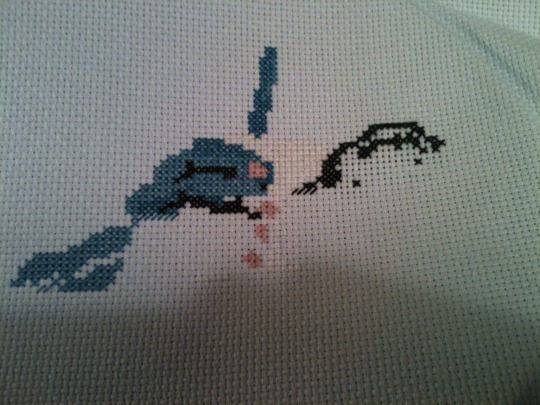
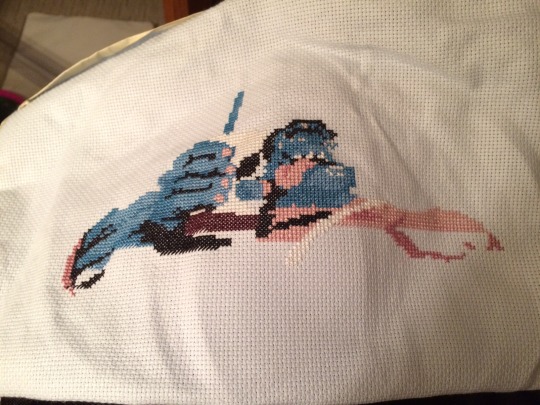


These WIP pics help showcase the individual stitches and backstitching a bit more.
#This is one of those art projects where you look back on it and can't believe you were the one who created it#Corporate Mundo#Dr Mundo#Mundo#League of Legends#lol#Like a Boss#cross stitch#needlepoint#kage posts
9 notes
·
View notes
Text
Heart Heist: The Zine Update 1.1 Out Now!
While work on the Complete Edition continues, Heart Heist: The Zine has also received its first major update!
Now that I understand itch's platform a bit better - as well as the scope of this project - it no longer seems correct to update the zine itself directly into the Complete Edition. I think it makes more sense to split Heart Heist into two bespoke editions: the cheap, easy to distribute, lowest-possible-barrier-of-entry Zine Edition; and a Complete Edition that is free to grow into whatever it ends up becoming. I don't want anyone who supported this project already to feel cheated out of the Complete Edition, which is why anyone who purchased (or purchases) the Zine Edition on itch will get $5 (the full price of the zine) off of the Complete Edition when it releases.
This does not mean that the zine is an unfinished version of a full game. Now it is quite the opposite - it is its own, complete thing (and has had its release stats on itch updated accordingly). It has everything you need to play, and can stand on its own. Some might come to call it a "rules-lite" version, and while I don't want to fall into the rabbit hole of definitions, it is looking very likely that the Complete Edition will have at least three more mechanics than its zine counterpart. Some players might even come to prefer one version over the other - relative simplicity and ease of use vs. mechanical depth and additional useful tools. Only time and continued development will tell.
While the Zine Edition obviously won't have everything the Complete Edition will have in it, it will still benefit from some of the updates work on the Complete Edition produces - such as the changes that released today!
Thank you for continuing to support Heart Heist!
Changelog:
Created a Google Sheet that helps automate calculating each Thief's Favor at the end of the game if you don't feel like doing math
Updated estimated play time based on additional playtesting with more groups of different players - down from 5 or 6 to 4 hours!
Added expectation of an additional 30 to 60 minutes if the entire group is new to playing Heart Heist
Added section strongly encouraging players to read their intel before meeting up to save time at the table. This section also explains that heists cannot be "spoiled," and are reusable!
The Evocative Language Update
"Stats" → "Vibes"
"Game Master" → "The Guy in the Van" (GV)
Removed unnecessary references to upcoming material meant for the Complete Edition
Rephrased explanation of "Fake It 'til you Make It" for clarity
Fixed unspecified print error on page 5
Added missing paragraph break on page 9
Fixed various typos
Removed grey sketch line from corner of Bingo.png
Fixed missing Alt Text for Bingo.png
Clarified that armor counts as a set of clothes
Specified how long it takes for a glass cutter to cut holes of various sizes
Reduced cost of the Aptitude spell from 3 to 2 Favor
Added advice for players to - at minimum - figure out how they will get in, how they will acquire the target, and how they will get back out again within their planning time limit. You'd be surprised how many groups forget one of those three things!
Added reminder for the Guy in the Van to award bonus Favor for the Dragon's Patron effect at the end of Phase 2: The Plan
Various tweaks to The Princess in the Box example heist based on continued playtesting
Added a timeline overview of the heist to The Princess in the Box
Increased margin size of The Princess in the Box intel handout for easier note taking
Updated the titles of some of the art pieces in the credits
7 notes
·
View notes
Text
Connecting the dots of recent research suggests a new future for traditional websites:
Artificial Intelligence (AI)-powered search can provide a full answer to a user’s query 75% of the time without the need for the user to go to a website, according to research by The Atlantic.
A worldwide survey from the University of Toronto revealed that 22% of ChatGPT users “use it as an alternative to Google.”
Research firm Gartner forecasts that traffic to the web from search engines will fall 25% by 2026.
Pew Research found that a quarter of all web pages developed between 2013 and 2023 no longer exist.
The large language models (LLMs) of generative AI that scraped their training data from websites are now using that data to eliminate the need to go to many of those same websites. Respected digital commentator Casey Newton concluded, “the web is entering a state of managed decline.” The Washington Post headline was more dire: “Web publishers brace for carnage as Google adds AI answers.”
From decentralized information to centralized conclusions
Created by Sir Tim Berners-Lee in 1989, the World Wide Web redefined the nature of the internet into a user-friendly linkage of diverse information repositories. “The first decade of the web…was decentralized with a long-tail of content and options,” Berners-Lee wrote this year on the occasion of its 35th anniversary. Over the intervening decades, that vision of distributed sources of information has faced multiple challenges. The dilution of decentralization began with powerful centralized hubs such as Facebook and Google that directed user traffic. Now comes the ultimate disintegration of Berners-Lee’s vision as generative AI reduces traffic to websites by recasting their information.
The web’s open access to the world’s information trained the large language models (LLMs) of generative AI. Now, those generative AI models are coming for their progenitor.
The web allowed users to discover diverse sources of information from which to draw conclusions. AI cuts out the intellectual middleman to go directly to conclusions from a centralized source.
The AI paradigm of cutting out the middleman appears to have been further advanced in Apple’s recent announcement that it will incorporate OpenAI to enable its Siri app to provide ChatGPT-like answers. With this new deal, Apple becomes an AI-based disintermediator, not only eliminating the need to go to websites, but also potentially disintermediating the need for the Google search engine for which Apple has been paying $20 billion annually.
The Atlantic, University of Toronto, and Gartner studies suggest the Pew research on website mortality could be just the beginning. Generative AI’s ability to deliver conclusions cannibalizes traffic to individual websites threatening the raison d’être of all websites, especially those that are commercially supported.
Echoes of traditional media and the web
The impact of AI on the web is an echo of the web’s earlier impact on traditional information providers. “The rise of digital media and technology has transformed the way we access our news and entertainment,” the U.S. Census Bureau reported in 2022, “It’s also had a devastating impact on print publishing industries.” Thanks to the web, total estimated weekday circulation of U.S. daily newspapers fell from 55.8 million in 2000 to 24.2 million by 2020, according to the Pew Research Center.
The World Wide Web also pulled the rug out from under the economic foundation of traditional media, forcing an exodus to proprietary websites. At the same time, it spawned a new generation of upstart media and business sites that took advantage of its low-cost distribution and high-impact reach. Both large and small websites now feel the impact of generative AI.
Barry Diller, CEO of media owner IAC, harkened back to that history when he warned a year ago, “We are not going to let what happened out of free internet happen to post-AI internet if we can help it.” Ominously, Diller observed, “If all the world’s information is able to be sucked up in this maw, and then essentially repackaged in declarative sentence in what’s called chat but isn’t chat…there will be no publishing; it is not possible.”
The New York Times filed a lawsuit against OpenAI and Microsoft alleging copyright infringement from the use of Times data to train LLMs. “Defendants seek to free-ride on The Times’s massive investment in its journalism,” the suit asserts, “to create products that substitute for The Times and steal audiences away from it.”1
Subsequently, eight daily newspapers owned by Alden Global Capital, the nation’s second largest newspaper publisher, filed a similar suit. “We’ve spent billions of dollars gathering information and reporting news at our publications, and we can’t allow OpenAI and Microsoft to expand the Big Tech playbook of stealing our work to build their own businesses at our expense,” a spokesman explained.
The legal challenges are pending. In a colorful description of the suits’ allegations, journalist Hamilton Nolan described AI’s threat as an “Automated Death Star.”
“Providential opportunity”?
Not all content companies agree. There has been a groundswell of leading content companies entering into agreements with OpenAI.
In July 2023, the Associated Press became the first major content provider to license its archive to OpenAI. Recently, however, the deal-making floodgates have opened. Rupert Murdoch’s News Corp, home of The Wall Street Journal, New York Post, and multiple other publications in Australia and the United Kingdom, German publishing giant Axel Springer, owner of Politico in the U.S. and Bild and Welt in Germany, venerable media company The Atlantic, along with new media company Vox Media, the Financial Times, Paris’ Le Monde, and Spain’s Prisa Media have all contracted with OpenAI for use of their product.
Even Barry Diller’s publishing unit, Dotdash Meredith, agreed to license to OpenAI, approximately a year after his apocalyptic warning.
News Corp CEO Robert Thomson described his company’s rationale this way in an employee memo: “The digital age has been characterized by the dominance of distributors, often at the expense of creators, and many media companies have been swept away by a remorseless technological tide. The onus is now on us to make the most of this providential opportunity.”
“There is a premium for premium journalism,” Thomson observed. That premium, for News Corp, is reportedly $250 million over five years from OpenAI. Axel Springer’s three-year deal is reportedly worth $25 to $30 million. The Financial Times terms were reportedly in the annual range of $5 to $10 million.
AI companies’ different approaches
While publishers debate whether AI is “providential opportunity” or “stealing our work,” a similar debate is ongoing among AI companies. Different generative AI companies have different opinions whether to pay for content, and if so, which kind of content.
When it comes to scraping information from websites, most of the major generative AI companies have chosen to interpret copyright law’s “fair use doctrine” allowing the unlicensed use of copyrighted content in certain circumstances. Some of the companies have even promised to indemnify their users if they are sued for copyright infringement.
Google, whose core business is revenue generated by recommending websites, has not sought licenses to use the content on those websites. “The internet giant has long resisted calls to compensate media companies for their content, arguing that such payments would undermine the nature of the open web,” the New York Times explained. Google has, however, licensed the user-generated content on social media platform Reddit, and together with Meta has pursued Hollywood rights.
OpenAI has followed a different path. Reportedly, the company has been pitching a “Preferred Publisher Program” to select content companies. Industry publication AdWeek reported on a leaked presentation deck describing the program. The publication said OpenAI “disputed the accuracy of the information” but claimed to have confirmed it with four industry executives. Significantly, the OpenAI pitch reportedly offered not only cash remuneration, but also other benefits to cooperating publishers.
As of early June 2024, other large generative AI companies have not entered into website licensing agreements with publishers.
Content companies surfing an AI tsunami
On the content creation side of the equation, major publishers are attempting to avoid a repeat of their disastrous experience in the early days of the web while smaller websites are fearful the impact on them could be even greater.
As the web began to take business from traditional publishers, their leadership scrambled to find a new economic model. Ultimately, that model came to rely on websites, even though website advertising offered them pennies on their traditional ad dollars. Now, even those assets are under attack by the AI juggernaut. The content companies are in a new race to develop an alternative economic model before their reliance on web search is cannibalized.
The OpenAI Preferred Publisher Program seems to be an attempt to meet the needs of both parties.
The first step in the program is direct compensation. To Barry Diller, for instance, the fact his publications will get “direct compensation for our content” means there is “no connection” between his apocalyptic warning 14 months ago and his new deal with OpenAI.
Reportedly, the cash compensation OpenAI is offering has two components: “guaranteed value” and “variable value.” Guaranteed value is compensation for access to the publisher’s information archive. Variable value is payment based on usage of the site’s information.
Presumably, those signing with OpenAI see it as only the first such agreement. “It is in my interest to find agreements with everyone,” Le Monde CEO Louis Dreyfus explained.
But the issue of AI search is greater than simply cash. Atlantic CEO Nicolas Thompson described the challenge: “We believe that people searching with AI models will be one of the fundamental ways that people navigate to the web in the future.” Thus, the second component in OpenAI’s proposal to publishers appears to be promotion of publisher websites within the AI-generated content. Reportedly, when certain publisher content is utilized, there will be hyperlinks and hover links to the websites themselves, in addition to clickable buttons to the publisher.
Finally, the proposal reportedly offers publishers the opportunity to reshape their business using generative AI technology. Such tools include access to OpenAI content for the publishers’ use, as well as the use of OpenAI for writing stories and creating new publishing content.
Back to the future?
Whether other generative AI and traditional content companies embrace this kind of cooperation model remains to be seen. Without a doubt, however, the initiative by both parties will have its effects.
One such effect was identified in a Le Monde editorial explaining their licensing agreement with OpenAI. Such an agreement, they argued, “will make it more difficult for other AI platforms to evade or refuse to participate.” This, in turn, could have an impact on the copyright litigation, if not copyright law.
We have seen new technology-generated copyright issues resolved in this way before.2 Finding a credible solution that works for both sides is imperative. The promise of AI is an almost boundless expansion of information and the knowledge it creates. At the same time, AI cannot be a continued degradation of the free flow of ideas and journalism that is essential for democracy to function.
Newton’s Law in the AI age
In 1686 Sir Isaac Newton posited his three laws of motion. The third of these holds that for every action there is an equal and opposite reaction. Newton described the consequence of physical activity; generative AI is raising the same consequential response for informational activity.
The threat of generative AI has pushed into the provision of information and the economics of information companies. We know the precipitating force, the consequential effects on the creation of content and free flow of information remain a work in progress.
13 notes
·
View notes
Text
Alright guys so I printed out a scale copy based on my original size for the quilt and, uh, it was big. Like, this wouldn't fit on a twin-sized bed big. So I've reduced the size a bit to something more manageable! (CD for scale, please ignore the other stuff in the room lol)
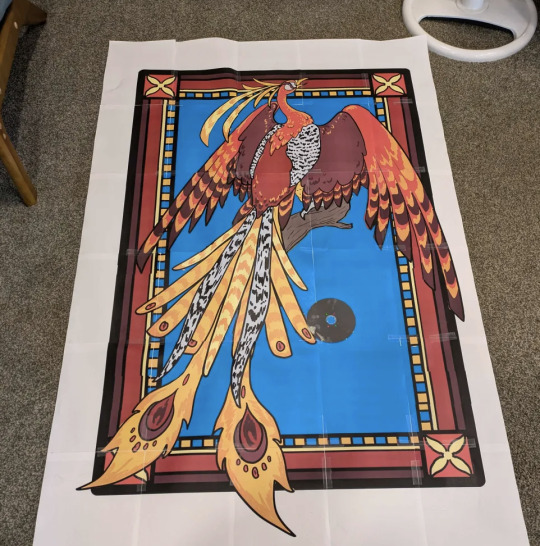
The new size will be approximately 52" high by 35"-ish wide.
Since I'm trying to make this as precise as possible I spent the evening struggling with math, lol. If people know any free, Mac-friendly programs I would appreciate it, haha. I made a mockup in Photoshop that I *think* is more exact but we won't know until I start assembling because, have I mentioned this before, I am terrible at math, lol.
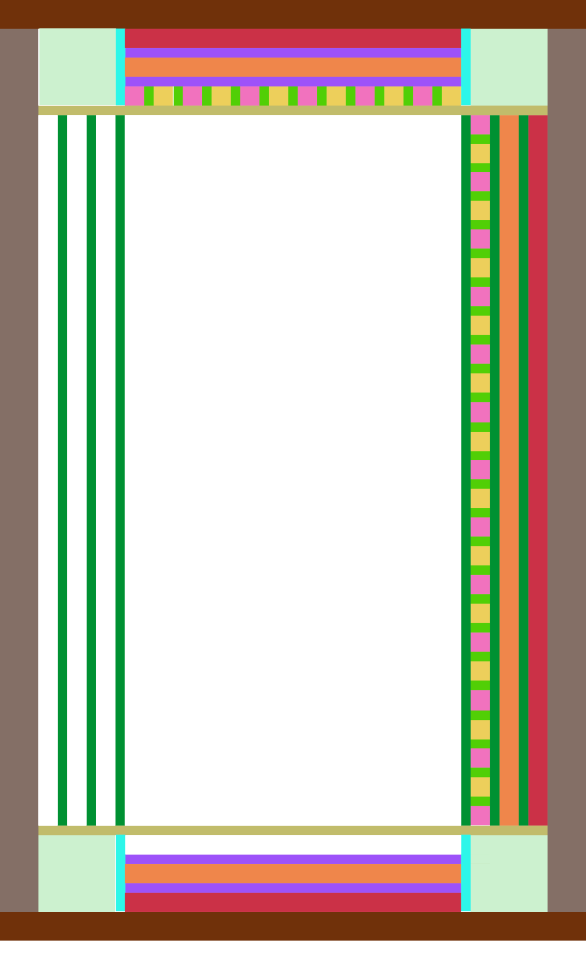
I made the mockup in this way because I can use the magic wand tool to get the precise measurements of what each of those pieces are, knowing that I'll need to add a 1/4 inch seam allowance to everything.
Based on my estimates I think I'm going to need the following approximate yardage (assuming the bolt is 40" wide cotton):
1/4 yard maroon for borders
1/4 yard red for borders
1/4 yard blue for squares
1/4 yard gold for squares
1/2 yard blue background
1 yard black for trims and binding
1/2 yard red bird
1/2 yard zebra white
1 yard red orange
1/2 yard magenta
1 yard gold
1/2 yard light yellow
1/2 yard green leaves
1/2 yard bark brown
+ assorted golds, gauzes, etc.
I'm going to a quilt show tomorrow to do some initial color and fabric scouting, wish me luck! I'll be sure to take pics of anything I bring home and keep you all posted. :)
#let's build a quilt#rin sews stuff#measuring....#math is the bane of my existence#why was astrophysics easier than figuring out simple math estimates lol
7 notes
·
View notes
Text
by Adam Zewe, Massachusetts Institute of Technology
"Imagine grasping a heavy object, like a pipe wrench, with one hand. You would likely grab the wrench using your entire fingers, not just your fingertips. Sensory receptors in your skin, which run along the entire length of each finger, would send information to your brain about the tool you are grasping."
"In a robotic hand, tactile sensors that use cameras to obtain information about grasped objects are small and flat, so they are often located in the fingertips. These robots, in turn, use only their fingertips to grasp objects, typically with a pinching motion. This limits the manipulation tasks they can perform."
"MIT researchers have developed a camera-based touch sensor that is long, curved, and shaped like a human finger. Their device provides high-resolution tactile sensing over a large area. The sensor, called the GelSight Svelte, uses two mirrors to reflect and refract light so that one camera, located in the base of the sensor, can see along the entire finger's length. The work has been published on the pre-print server arXiv.
In addition, the researchers built the finger-shaped sensor with a flexible backbone. By measuring how the backbone bends when the finger touches an object, they can estimate the force being placed on the sensor.
They used GelSight Svelte sensors to produce a robotic hand that was able to grasp a heavy object like a human would, using the entire sensing area of all three of its fingers. The hand could also perform the same pinch grasps common to traditional robotic grippers."

25 notes
·
View notes
Text
Mastering Liquidity Pools on STON.fi: A Beginner’s Guide

Ever walked into a bustling marketplace where every stall has something to offer? That’s how liquidity pools work in the world of DeFi, and on STON.fi, it’s like having access to the VIP section of the market. But before you dive in, let’s break it down in a way that makes sense and feels practical.
In this guide, we’ll explore how to evaluate liquidity pools using three easy-to-grasp ideas: Pool Size (TVL), Earnings (APR), and Activity (Trading Volume). And yes, there’ll be analogies and examples to make it crystal clear!
1. Pool Size (TVL): The Marketplace Crowd
Imagine you’re setting up a stall in a market. The number of shoppers in the market represents TVL (Total Value Locked) in a liquidity pool.
Large Crowd (High TVL):
If the market is packed, your stall gets consistent traffic, but you’re competing with many other vendors. Similarly, pools with high TVL on STON.fi are stable and reliable but might offer lower individual rewards because the profits are shared among many liquidity providers.
Quiet Market (Low TVL):
A smaller crowd might mean less competition, but fewer buyers also means higher risk. Low TVL pools on STON.fi can yield better rewards, but only if the demand holds steady.
Example: Imagine adding $1,000 worth of liquidity to a STON.fi pool with $100K TVL. Your share is 1%. If trading fees generate $10,000 in a month, you’d earn $100.
2. Earnings (APR): Your Paycheck
Think of APR (Annual Percentage Rate) as your potential paycheck for participating in a liquidity pool. It shows how much you could earn over a year.
Sky-High Offers (High APR):
Ever seen a job offering double the industry salary? Tempting, but you’d wonder about the catch. Pools with high APRs can be rewarding but often come with risks like volatile token prices or unstable rewards.
Steady Income (Consistent APR):
A job with a solid, dependable paycheck is always appealing. Pools with moderate, consistent APRs on STON.fi are great for those who prefer long-term stability.
Example: If a pool offers 50% APR and you deposit $1,000, you’d earn $500 in a year—assuming no major changes. But always account for fluctuations in token prices.
3. Activity (Trading Volume): The Busy Stall
Picture your market stall again. The more customers buying and selling, the more profit you make. Trading volume works the same way—it’s the lifeblood of a liquidity pool.
High Volume:
Pools with active trading generate more fees for liquidity providers. On STON.fi, popular pairs like $TON often have high trading volume, meaning more frequent earnings.
Low Volume:
A quiet stall might not bring in much income. Similarly, pools with low trading volume might not generate enough fees to offset risks like impermanent loss.
Example: If a STON.fi pool has $1 million in trades daily and a 0.3% fee, that’s $3,000 in daily rewards for liquidity providers.
Check the STONFI Dex for available pools
Bonus Insights: Things You Must Know
Impermanent Loss:
Ever sold something for less than it’s worth because the market shifted? That’s impermanent loss in a nutshell. It’s the difference between holding your tokens and providing liquidity. Use STON.fi’s tools to estimate this before committing.
Security Matters:
Trust is everything. STON.fi operates on The Open Network (TON) blockchain, ensuring transactions are secure and smart contracts are audited. But always double-check the fine print.
Why STON.fi Stands Out
STON.fi isn’t just another DEX; it’s a powerhouse for DeFi enthusiasts. With its user-friendly interface, real-time analytics, and innovative farm pools, it’s like having a personal trading assistant. Whether you’re a beginner or a pro, STON.fi has options that fit your goals.
Your Strategy Matters
Understanding the size, activity, and earnings of a liquidity pool can make or break your DeFi journey. On STON.fi, the tools and opportunities are at your fingertips—use them wisely.
So, ready to set up your stall in the DeFi marketplace? Explore STON.fi today and start making your crypto work for you.
Remember, in DeFi, knowledge isn’t just power—it’s profit.
4 notes
·
View notes
Text
Okay for some reason my brain has forgotten how to figure out percent, so just correct me if I'm wrong ToT
I read 默读 chapter 1 last night. I wanted to see if I understand more this time, compared to around a year ago when I read some of it. I read while listening with Microsoft Edge's Read Aloud (best TTS voice), and then opened up 默读 in my KursX Smart Book app (which I recommend as a parallel reading tool). The Smart Book app gives me statistics like: how many words I looked up, how many words I read per minute, percentage of the book I finished etc.
I read 135 words per minute, for 12 minutes, looking up a word (on average) for every 7 words. I did look up some words I knew (since I am refreshing my memory lol on rusty words I once knew in reading) and I mainly looked up words in descriptive 4 hanzi chunks because I've forgotten the meaning a lot of those types of phrases and wanted to listen to them a few times to remember their pronunciation . Since during the initial read in Edge, I was just guessing those 4 hanzi phrase meanings. So 1 lookup for every 7 words means... okay how the fuck do i do percentage? So 7 is in 100 a little over ~14 times, and so 14/100 is the amount I did not understand %14, so the amount understood was 86%. Is that how to calculate that?
And then... based on my own judgement, I did lookup some words multiple times or vaguely knew them and was just confirming, So lets guess my actual comprehension at 90%. 1 because I'd like to be optimistic... but 2, because I really did understand it fine while reading in Edge - except for 矛盾, and a few 4 hanzi descriptions. Or of course, I could just stick with the lower estimate of 86% understood and focus on trying to improve from there.
To compare: when I read 镇魂, I only look up a word for every 23 words. So... for percent comprehended that is... 23 is in 100 about ~4.35 times, 4.35/100 is about 4.35% i did not understand, or 95.65% of the text I do understand. So for me 镇魂 is within the range of 95-100% comprehension where a person can read extensively (not look words up) without intense effort and can understand what is going on and pick up new words. I was already aware my comprehension is around 96% of the text, because back when I was reading the print version a lot i manually calculated how many hanzi I did not recognize per page versus did.
So on the upside? I only need to work on learning 9% more words (whatever that ends up being in actual count) to read 默读 comfortably in print, or just without feeling the need to look words up.
#rant#progress#reading progress#i really like the Smart Book Kursx app#its free! also very beginner friendly#it can make MTL Parallel Text translations for beginners to use if you need that level of translation#or it can let you read MTL and look up a key word here or there. even if ur an amateur translator or webnovel reader who knows#NO language stuff yet... it can help you clarify a mtl youre reading. so you have a clearer idea of what the plot is
2 notes
·
View notes
Text
From Connections to Commissions | Affiliate Marketing with LinkedIn
Affiliate Marketing with LinkedIn

LinkedIn, frequently dubbed as the professional networking platform, has evolved beyond its original purpose of connecting professionals and job campaigners. It has become an important tool for businesses and individuals to engage in chapter marketing, tapping into its vast network of professionals and assiduity-specific communities. In this composition, we'll explore how you can work LinkedIn effectively for chapter marketing purposes.
Preface to Affiliate Marketing on LinkedIn
Affiliate marketing involves promoting products or services and earning a commission for every trade or lead generated through your referral. LinkedIn provides a unique terrain for chapter marketers due to its focus on professional networking and business-acquainted content.
Understanding the Basics of Affiliate Marketing
What's Affiliate Marketing?
chapter marketing is a performance-grounded marketing strategy where cells earn a commission for driving deals or leads to a trafficker's website through their marketing sweats.
How Does Affiliate Marketing Work?
Affiliates are handed unique shadowing links or promo canons, which they use to promote products or services. When a stoner makes a purchase or completes a asked action through the chapter's link, the chapter earns a commission.
Using LinkedIn for Affiliate Marketing
Building a Professional Profile
Your LinkedIn profile serves as your professional identity on the platform. Optimize it by pressing your moxie, chops, and applicable experience to attract your target followership.
Expanding Your Network
Connect with professionals in your assiduity and related fields to expand your network. Engage with their content and share in applicable conversations to establish credibility and visibility.
Chancing the Right Affiliate Products or Services
Probing Affiliate Programs
Explore chapter networks and platforms to find products or services that align with your niche and target followership. Look for estimable merchandisers with high- quality immolations and competitive commission rates.
Choosing the Right Niche
Identify a niche request or assiduity where you can give value and break problems for your followership. Focus on areas where you have moxie or genuine interest to produce authentic content and recommendations.
Creating Compelling Content on LinkedIn
Writing Engaging Posts and papers
Craft compelling content that educates, entertains, or inspires your followership. Share precious perceptivity, tips, and recommendations related to the products or services you are promoting.
Exercising illustrations and Multimedia
Incorporate visual rudiments similar as images, infographics, and vids to enhance the appeal and engagement of your content. illustrations can effectively convey information and prisoner the attention of your followership.
Engaging with Your followership
Responding to commentary and dispatches
Be visionary in engaging with your followership by responding to commentary, dispatches, and inquiries instantly. Foster meaningful exchanges and make connections with your followers.
Hosting Webinars and Live Sessions
Organize webinars, live Q&A sessions, or virtual events to connect with your followership on a deeper position. Share precious perceptivity, demonstrate products, and address common questions or enterprises.
Tracking and assaying Your Performance
Using LinkedIn Analytics
Use LinkedIn's analytics tools to track the performance of your posts, papers, and overall engagement criteria. Examiner crucial criteria are similar as prints, clicks, and conversion rates to assess the effectiveness of your chapter marketing sweats.
Conforming Strategies for Optimization
Grounded on your analytics data, upgrade your content strategy and promotional tactics to optimize your chapter marketing juggernauts. trial with different formats, messaging styles, and posting schedules to maximize your reach and impact.
Maintaining translucency and Compliance
Telling Affiliate connections
Ensure translucency by telling your chapter connections and any implicit conflicts of interest to your followership. figure trust and credibility by being honest and outspoken about your confederations.
Clinging to LinkedIn's programs
Familiarize yourself with LinkedIn's programs and guidelines regarding promotional content, signatures, and patronized posts. Avoid violating platform rules and regulations to maintain your professional character.
Conclusion
LinkedIn offers immense openings for chapter marketers to connect with professionals, showcase their moxie, and drive meaningful transformations. By using the platform's features effectively and espousing stylish practices, you can produce a successful chapter marketing strategy that resonates with your target followership.
#AffiliateMarketing#LinkedInMarketing#DigitalMarketing#AffiliatePrograms#OnlineBusiness#SocialMediaMarketing#Entrepreneurship#MarketingTips#ContentMarketing#InfluencerMarketing#BusinessNetworking#AffiliateSuccess#LinkedInTips#AffiliateStrategy#ProfessionalNetworking#AffiliateCommunity#MarketingStrategy#AffiliateSales#LinkedInGrowth#AffiliateIncome#LinkedInProfits#AffiliatePromotion#LinkedInConnections#AffiliateNetwork#LinkedInForBusiness
3 notes
·
View notes